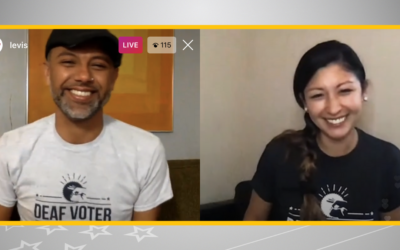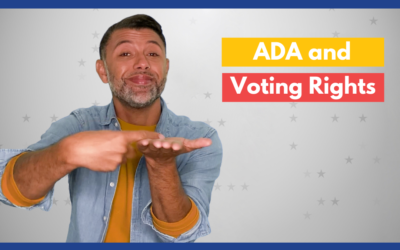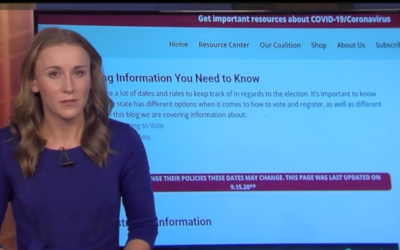What’s on the State Ballot
Every state election has different candidates and issues. Sometimes state elections impact your daily life more than the federal ones!
In the fourth episode of the #SignVote Series: Election 2020, we explain what’s on the state ballot. 🗳
Stay tuned 👀 for the next video in our series!
Special thanks to ASLized, DPAN.TV, National Association for the Deaf, and The Center of Democracy in Deaf America!
[TRANSCRIPT with visual descriptions: Text on screen reads: WHAT’S ON THE BALLOT FOR STATE LEVEL ELECTIONS? SignVote logo appears before transitioning to Kriston Pumphrey, a dark tanned mid-thirties gentleman with short trimmed salt and peppered beard wearing a button-up denim shirt in front of an animated background. As the video progresses, graphics appear on screen to support his message. Kriston’s message is in American Sign Language and accompanied by a voiceover.]
Okay, do you remember the three general categories for ballots? Federal, state, and local/county. Today’s topic is state ballots. State ballots are different in each state because of the U.S. Constitution, which allows powers to the states to make certain decisions. All 50 states have governors who have executive powers like the president does, just on a state level. Sometimes, Governors are up for election at the same time as the president, or during midterms. Governors serve for four-year terms, and some states have limits on how many terms a governor can serve. Maybe one or two terms, or no limit at all.
State ballots also have representatives for your state legislature, and states can have different kinds of legislatures too. The State and General Assembly, House of Delegates, State Representatives, and Senators are all examples. Keep in mind, most states have the same structure to comprise Congress, like they have upper and lower houses – the Senate and the House of Representatives. This concept is the same for all states. What’s different, though, is how often the legislatures come together to meet. Some states will meet often and work year-round, while others may only meet a few times a year for short sessions.
During state elections, we also vote for other important positions, like Attorney General, or Lieutenant Governor (that position is kind of like an assistant or VP governor)! Attorney Generals are super important, because they set guidelines for laws and courts. One example would be if someone was charged with having marijuana, would they be prosecuted?
So because of The U.S. Constitution’s principle of federalism, and the 10th amendment, states are different in the decisions they make and how they are run. The 10th amendment makes sure that the states have the rights to make those decisions, for any rights that aren’t already stated in the Constitution. The goal of this is to protect liberty and the diverse population in our country. So really, this means that states can do some things that the federal government can’t do, like health-related decisions during the pandemic. Should restaurants stay closed or opened? That decision is up to the state.
And get this, state-level powers have even more of an impact on citizens than federal level decisions, for example, decisions related to health, criminal justice, education, taxes, housing, and more…these all have a direct impact on those state citizens. Even more than at the federal level.
Here’s an example: In California, their state elections have propositions. That means statewide ballot measures (keep in mind there are different kinds of measures), but in any case, those measures can actually skip elected representatives when it comes to making laws. So, either a lawmaker writes a law but cannot vote on it, or the population collects signatures for a new proposal. There are a few different ways a proposition can make it to a ballot, but importantly, it’s the California voters who make the decision to approve or reject that law.
This year, 2020, California voters will be voting on a few important things including cash bail and stricter rent control. Four states, Arizona, Montana, New Jersey and South Dakota will be voting on recreational marijuana initiatives. But wait…what’s an initiative? It’s the proposal of a new law or amendment to the Constitution. With enough people supporting a petition, a new law or amendment can be added.
This year’s 2020 Presidential election also has other big areas of focus that are up for a vote by the people. Here’s an example: 14 states are voting on election-related policies like you can see here. Did you know that the actual election policies are sometimes more important than the presidential election itself?? Another important topic: Taxes, and tax-related policy decisions. 12 states will be voting on 19 different issues related to taxes, shown here.
Before we wrap up, I know we only scratched the surface on a few things. Propositions and initiatives- what do those mean and how are they different? What a great chance to do some more research about that. It’s so important to be a well-informed voter and understand how the system works.
I’ll leave you with this: Every state election has differences. Different candidates, issues, both old and new. This all has an impact on your daily life, sometimes even more than what happens on the federal level. That’s why it’s so important to stay involved and aware of the happenings in your state, and who and what you’re voting for. Thank you for watching!
[Video ends with a SignVote logo and credit roll. Screen fades to black. Video ends.]
[TRANSCRIPCIÓN con descripciones visuales: El texto en la pantalla dice: ¿QUÉ HAY EN LA BOLETA PARA LAS ELECCIONES A NIVEL ESTATAL? El logotipo de SignVote aparece antes de hacer la transición a Kriston Pumphrey, un caballero bronceado de mediados de los años treinta con una barba corta y con una barba corta y moteada que lleva una camisa de mezclilla abotonada frente a un fondo animado. A medida que avanza el video, aparecen gráficos en la pantalla para respaldar su mensaje. El mensaje de Kriston está en lenguaje de señas americano y está acompañado de una voz en off.]
Bien, ¿recuerdas las tres categorías generales de papeletas? Federal, estatal y local / condado. El tema de hoy son las votaciones estatales. Las boletas estatales son diferentes en cada estado debido a la Constitución de los Estados Unidos, la que otorga poderes a los estados para tomar ciertas decisiones. Los 50 estados tienen gobernadores que tienen poderes ejecutivos como el presidente, sólo a nivel estatal. A veces, los gobernadores son elegidos al mismo tiempo que el presidente, o durante las elecciones intermedias. Los gobernadores sirven por períodos de cuatro años, y algunos estados tienen límites sobre cuántos períodos puede servir un gobernador. Tal vez uno o dos términos, o ningún límite en lo absoluto.
Las boletas estatales también tienen representantes para su legislatura estatal, y los estados también pueden tener diferentes tipos de legislaturas también. El Estado y la Asamblea General, la Cámara de Delegados, los Representantes del Estado y los Senadores son todos ejemplos. Tenga en cuenta que la mayoría de los estados tienen la misma estructura para integrar el Congreso, al igual que tienen cámaras alta y baja – el Senado y la Cámara de Representantes. Este concepto es el mismo para todos los estados. Sin embargo, lo que es diferente es la frecuencia con la que las legislaturas se unen para reunirse. Algunos estados se reunirán con frecuencia y trabajarán durante todo el año, mientras que otros solo se reunirán unas pocas veces al año para sesiones cortas.
Durante las elecciones estatales, también votamos por otros puestos importantes, como Fiscal General o subgobernador (¡ese puesto es como un asistente o vicegobernador)! Los fiscales generales son muy importantes porque establecen pautas para las leyes y los tribunales. Un ejemplo sería si alguien fuera acusado de tener marihuana, ¿sería procesado?
Entonces, debido al principio de federalismo de la Constitución de los Estados Unidos y la décima enmienda, los estados son diferentes en las decisiones que toman y cómo se administran. La décima enmienda asegura que los estados tengan el derecho de tomar esas decisiones, por cualquier derecho que no esté ya establecido en la Constitución. El objetivo de esto es proteger la libertad y la población diversa en nuestro país. En realidad, esto significa que los estados pueden hacer algunas cosas que el gobierno federal no puede hacer, como decisiones relacionadas con la salud durante la pandemia. ¿Los restaurantes deben permanecer cerrados o abiertos? Esa decisión depende del estado.
Y entienda esto, los poderes a nivel estatal tienen un impacto aún mayor en los ciudadanos que las decisiones a nivel federal, por ejemplo, las decisiones relacionadas con la salud, la justicia penal, la educación, los impuestos, la vivienda y más … todos estos tienen un impacto directo en esos ciudadanos del estado. Incluso más que a nivel federal.
Aquí hay un ejemplo: en California, sus elecciones estatales tienen propuestas. Eso significa medidas de votación en todo el estado (tenga en cuenta que hay diferentes tipos de medidas), pero en cualquier caso, esas medidas pueden omitir a los representantes electos cuando se trata de hacer leyes. Entonces, o un legislador escribe una ley pero no puede votar sobre ella, o la población recolecta firmas para una nueva propuesta. Hay algunas formas diferentes en que una propuesta puede llegar a una boleta, pero lo más importante es que son los votantes de California quienes toman la decisión de aprobar o rechazar esa ley.
Este año, 2020, los votantes de California votarán sobre algunas cosas importantes, incluida la fianza en efectivo y un control de alquiler más estricto. Cuatro estados, Arizona, Montana, Nueva Jersey y Dakota del Sur votarán sobre iniciativas de marihuana recreativa. Pero espere … ¿qué es una iniciativa? Es la propuesta de una nueva ley o enmienda a la Constitución. Con suficientes personas apoyando una petición, se puede agregar una nueva ley o enmienda.
Las elecciones presidenciales del 2020 de este año también tienen otras grandes áreas de enfoque que están siendo sometidas a votación por la gente. Aquí hay un ejemplo: 14 estados están votando sobre políticas relacionadas con las elecciones, como puede ver aquí. ¿Sabía que las políticas electorales reales a veces son más importantes que las elecciones presidenciales en sí? Otro tema importante: impuestos y decisiones de política relacionadas con impuestos. 12 estados votarán sobre 19 temas diferentes relacionados con los impuestos, que se muestran aquí.
Antes de terminar, sé que solamente tocamos la superficie en algunas cosas. Propuestas e iniciativas- ¿qué significan y en qué se diferencian? Qué gran oportunidad para investigar un poco más sobre eso. Es muy importante ser un votante bien informado y comprender cómo funciona el sistema.
Los dejo con esto: cada elección estatal tiene diferencias. Diferentes candidatos, temas, tanto antiguos como nuevos. Todo esto tiene un impacto en su vida diaria, a veces incluso más que lo que sucede a nivel federal. Por eso es tan importante mantenerse involucrado y estar al tanto de los acontecimientos en su estado, y por quién y por qué está votando. ¡Gracias por ver!
[El video termina con un logotipo de SignVote y una lista de créditos. La pantalla se vuelve negra. El video termina.]




